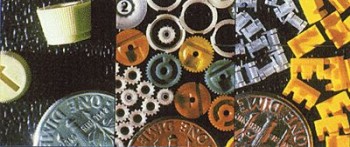Search Case Studies
End-Use Case Study
 Imagine! Complex engineering plastic parts no bigger than the letter on your phone dial. What a challenge to the designers, the material supplier, and the processor. The photograph above shows a variety of trimming potentiometers which are miniature devices that perform various adjustment functions in all types of electronic circuits. BOURNS, Inc. headquartered in Riverside, California, is the world’s leading supplier of these devices. Their largest captive molding facility of potentiometers is in Ames, Iowa. Major markets include computers, office automation, military/aerospace, telecommunications, instrumentation and process control.
Imagine! Complex engineering plastic parts no bigger than the letter on your phone dial. What a challenge to the designers, the material supplier, and the processor. The photograph above shows a variety of trimming potentiometers which are miniature devices that perform various adjustment functions in all types of electronic circuits. BOURNS, Inc. headquartered in Riverside, California, is the world’s leading supplier of these devices. Their largest captive molding facility of potentiometers is in Ames, Iowa. Major markets include computers, office automation, military/aerospace, telecommunications, instrumentation and process control.
The tiny white sliders in group 3 in the photo are so small that 3 parts can be molded from 1 pellet! Typical sizes of the more than 50 models are 3-5 cm lengths and diameters of 5-6 cm. As surface mounted devices on printed circuit boards, these miniature components permit significant reductions in circuit board size, improving performance and increasing component density.
The challenge to the material supplier is to formulate materials which meet the part requirements and produce them to spec with lot-to-lot consistency. The major specification involves pellet size. Because of the small feed throat opening used for molding small parts, a 3/32 in diameter x 1/8 in long pellet is required to prevent feeding problems caused by bridging. Fines and double pellets must be screened out before shipping.
Secondly, the addition of glass fiber to the compound must be well dispersed to prevent the plugging of gates.
In addition, usually both an internal and external lubricant is needed to push the material through the molding machine and provide release of the tunnel-gated molded parts. The post blended external lubricant must be well dispersed to prevent balling up in the throat.
In the examples above, device #1 is a special cap used to convert a screwdriver actuated trimmer to a thumb adjust style. The material is RTP 1005 FRA, which is a flame retardant, glass fiber reinforced polyester selected for its temperature and chemical resistance. Devices in the second group are various gears and rotors used in the drive mechanisms of single-turn and multi-turn trimmers. They are molded from RTP 205 TFE 5, a glass fiber reinforced nylon 6/6, with PTFE compounded in. The glass/nylon provides strength and the PTFE provides wear resistance. Color coding is the most efficient way of identifying similar models. Sliders used in various lead screw actuated trimmers are shown in the third grouping. The materials of choice are RTP 201 and RTP 201 HS, grades of glass fiber reinforced nylon 6/6 selected for high strength and wear resistance.
The RTP materials are specified because of the consistent quality of the materials, the availability of good technical service, prompt delivery, and color match capabilities.
Bourns Trimpot® potentiometer line leads the industry in quality and is close to achieving their goal of fewer than ten parts per million shipped not meeting specifications — a 0.001% acceptable quality level (AQL)! RTP Company is proud to play a part in that achievement.




